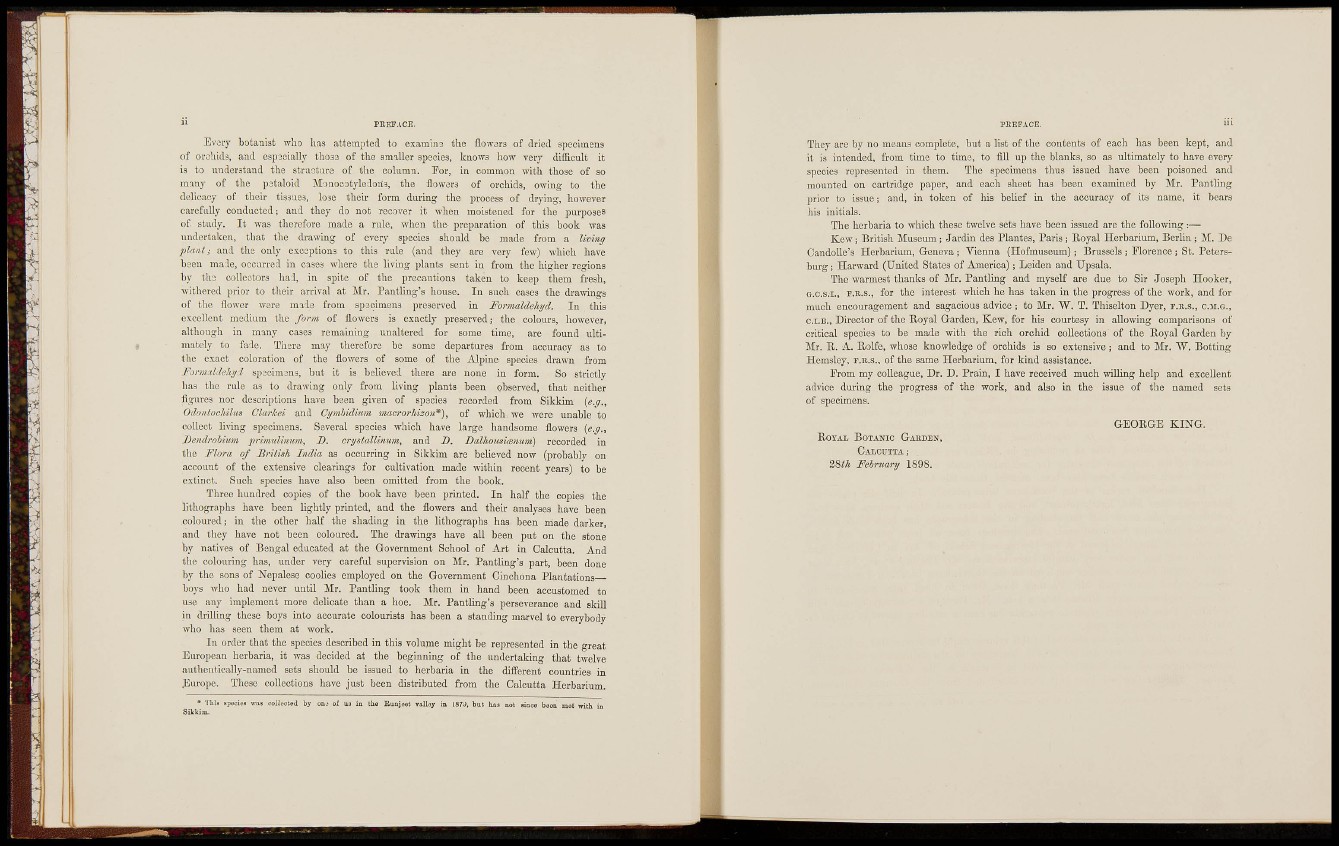
\ f i
H
Every botanist wlio lias attempted to examins the flowers of dried specimens
of orchids, aud especially those of the smaller species, kuow's how very dilScalt it
is to understand the structure of the column. Eor, in common "with those of so
many of the petaloid Monocofcyledoiia, the flowers of orchids, owing to the
delicacy of their tissues, lose their form during the process of drying, however
carcfally conducted j and they do not recover it when moistened for the purposes
of study. It was therefore made a rule, when the- preparation of this hook was
undertaken, that the drawing of every species should be made from a living
•plant; and the only exceptions to this rule (and they are very few) which have
been male, occurred in cases where the living plants sent in from the higher regions
by the collectors had, in spite of the precautions taken to keep them fresh,
withered prior to their arrival at llv. Pantling's house. In such cases the drawings
of the ilowcr were made from specimens preserved in Formaldehjd. In this
excellent medium the form of flowers is exactly preserved; the colours, however,
although in many cases remaining unaltered for some time, are found ultimately
to fade. There may therefore be some departures from accuracy as to
the cxact coloration of the flowers of some of the Alpine species dra-wn from
Formnldehyd specimens, but it is believed there are none in form. So strictly
has the rule as to drawing only from livmg plants been observed, that neither
figures nor descriptions have been given of species recorded from Sikkim [e.g.,
OdontocUliis Clarhei and CymUdium macrorUzon*), of which, we were unable to
collect living specimens. Several species which have large handsome flowers {e.g..,
Dendrohhm frimulimm, B. cri/stalUnum, and D. Ddhousimium) recorded in
the Flora of British India as occurring in Sikkim are believed now (probably on
account of the extensive clearings for cultivation made within recent years) to be
cxtinct. Such species have also been omitted from the book.
Three hundred copies of the book have been printed. In half the copies the
lithographs have been Hghtly printed, and the flowers and their analyses have been
coloured; in the other half the shading in the lithographs has been made darker,
and they have not been coloured. The drawings have all been put on the stone
by natives of Bengal educated at the Government School of Art in Calcutta. And
the colouring has, under very careful supervision on Mr. Pantling's part, been done
by the sons of Nepalese coolies employed on the Government Cinchona Plantations—
Ijoys who had never until Mr. Pantling took them in hand been accustomed to
use any implement more delicate than a hoe. Mr. Pantling's perseverance and skill
in drilling these boys into accurate colourists has been a standing marvel to everybody
who has seen them at work.
I n order that the species described in this volume might be represented in the great
European herbaria, it was decided at the beginning of the undertaking that twelve
authentically-named sets should be issued to herbaria in the different countries in
Europe. These collections have just been distributed from the Calcutta Herbarium.
They are by no means complete, but a list of the contents of each has been kept, and
it is intended, from time to time, to fill up the blanks, so as ultimately to have every
species represented in them. The specunens thus issued have been poisoned and
mounted on cartridge paper, and each sheet has been examined by Mr. Pantling
prior to issue; and, in token of Ms belief in the accuracy of its name, it bears
his initials.
The herbaria to which these twelve sets have been issued are the following:—
Kew; British Museum; Jardin des Plantes, Paris; Eoyal Herbarium, Berlin; M. De
Gandolle's Herbarium, Geneva ; Vienna (Hofmuseum); Brussels ; Florence ; St. Petersburg
; Harward (United States of America); Leiden and Upsala.
The warmest thanks of Mr. Pantling and myself are due to Sir Joseph Hooker,
G.C.S.I., F.R.S., for the interest which he has taken in the progress of the work, and for
much encouragement and sagacious advice ; to Mr. "W. T. Thiselton Dyer, R.u.s., C.M.G.,
C.I.E., Director of the Royal Garden, Kew, for his courtesy in allowing comparisons of
critical species to be made with the rich orchid collections of the Royal Garden by
Mr. R. A. Rolfe, whose knowledge of orchids is so extensive; and to Mr. "W. Botting
Hemsley, r.R.s., of the same Herbarium, for kind assistance.
From my colleague, Dr. D. Prain, I have received much willing help and excellent
advice during the progress of the work, and also in the issue of the named sets
of specimens.
GEORGE KING.
ROTAL BOTANIC GAEDEN,
CAXCUTTA ;
%Sth Pebntary 1898.
" Tills specie a T ! coJieoted by on,- of v 1 the Eunjeet valloy in I87ii, but has i